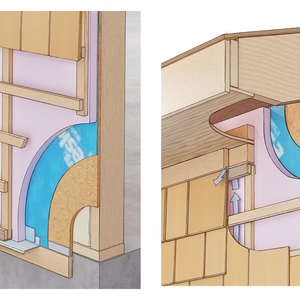Rabbetting door jambs and other door ?s
I’m trying to replace the rotten, busted-a$$ front and rear entry door frames on the house. They’ve got a transom window above each, and due to the depth of the door opening (12.5″) and height (97″ including the transom), I have to cut my own jamb stock since no one carries anything more than 6 5/8″ jamb stock in 6/8 heights.
So this past weekend, I pulled the back door frame out (it was only held in by two nails anyways), and I experimented with making my own one piece frame, with the transom integrated, from regular 2×12 stock, cutting 1/2″ rabbets in the jamb with a router. Other than generating a ton of sawdust and noise, this worked okay, but didn’t leave the cleanest of rabbets, due probably more to my technique than anything else. Would cutting them on a table saw be a better technique for these long rabbets?
Also, the original frames on the house have one piece jambs have a rabbet for the top door jamb/bottom of transom frame horizontal. All the millwork shops I’ve called about getting a replacement door and frame make the door frame and transom frame in separate pieces, then use mouldings to cover up the joints. I’d like to replicate the existing style with the new frames, which precludes me from using much molding to disguise the separate frames.
Unfortunately while making my backdoor frame, I found it quite difficult to get both the door opening square and the transom opening square. Mostly a result of my crappy woodworking skills and the lack of good lumber, but before I throw in the towel on this, is trying to make one piece jambs just stupid? or stupidly difficult? Or is there a better way to make my own jambs?
I have to make another back door frame to make it 1/4″-1/2″ narrower so I can get the frame square in the racked opening. Since it’s on the back of the house, I’m more than willing to try any suggestions you all have 😉
Thanks,
Z



















Replies
If ya gotta make 'em, why not laminate lumber to form the rabbet? 3/4 jamb, 1/2" stop full depth of jamb. You could put the kerf in for weatherseal easy enough this way too.
Re read your post...that's some deeeep door frames. If it's painted I would be tempted to use plywood....like MDO and at least prime the whole sheband before install.
What sort of exposure do they get? Water?
View Image
Everything will be okay in the end. If it's not okay, it's not the end.
Edited 11/5/2008 5:56 pm ET by PeterJ
Dope slap to myself! Brilliant! I was wondering how to get that kerf in there for the weather stripping.DOH! Thanks for the idea!Z
This might not be what you want to hear. Making a door jamb with an integral stop and a transom on top isn't what I would consider ruff carpentry.
I'd step back and re-asses the project. This is finish carpentry and you should take a different approach if you want good results.
I'd sit down and draw it out. Take a materials list off the drawings and go to a lumber yard that has the stock you will need.
Go into a shop setting with a table saw and mill the lumber. Cut it to length.
Mortise it. Whatever it takes.
It's more about the approach than the technique.
Edited 11/5/2008 6:45 pm ET by popawheelie
It tends to be a function of just how big your tablesaw is. I've actually cut the rabbet on jambstock,, including the overcut to make the kerf for Q-lon weather-stripping, on a little Makita.....but it's a pain.
Helps to use really nice -read expensive- clear white pine stock. I wouldn't like to do it with reg. 2x12
Nothing wrong with laminating it, but I prefer one piece....